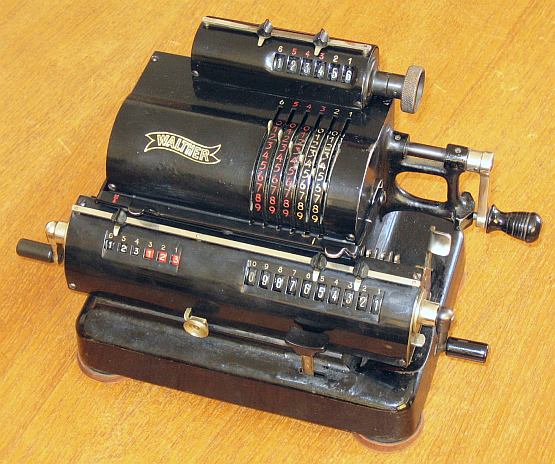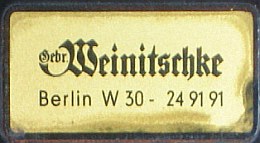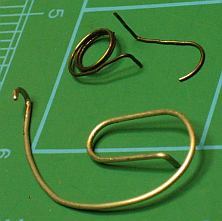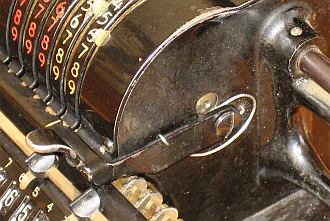previous <<==>> next
WALTHER RK *)

T E C H N I C A L D A T A of the Mechanical Calculator WALTHER » RK «
*************************************************************************
(* There is NO MODEL NAME on the calculator )
Serial Number: 4484
Dimensions: (ca.) Width = 10_1/4" / 26 cm
Depth = 5_1/2" / 14 cm
Height = 5_1/2" / 14 cm
Weight: (ca.) 10_3/4 lbs / 4.9 kg
Mechanics: Pin-Wheel / Sprossenrad
10s Carry Mechanism
Counter Stepping Mechanism + Animation
Functions: Add, Subtract, Multiply, Divide
Registers: Input = 6 Decimals
Counter = 6 Decimals ( NO 10s-Carry )
Arithmetic = 10 Decimals
Manufacturer:
CARL WALTHER
Waffenfabrik
Zella-Mehlis in Thueringen
Germany
1926
H O W T O U S E the WALTHER » RK «
*******************************************
BASIC SETTINGS:
===============
(A) Crank:
----------
For addition (+) the crank is turned clockwise; for subtraction (-) the
crank is turned counter-clockwise. In the idle position the crank is DOWN
& LOCKED. To make one or more turns with the crank, pull out the handle to
unlock. When finished the turn(s), let the handle snap into lock again. The
locked down position only makes other functions (ex. clearing) accessible.
REMARK: Every started turn has to be finished completely!
Accidentally started turns are correctible somehow.
(B) Clearing Registers:
-----------------------
The input:
With the BIG LEVER the INPUT can be cleared simultaniously.
(It is intended to use the thumb for.)
**) The KNOP ON TOP - See Remarks ...
The counter unit
will be cleared with the CRANK on the LEFT SIDE of the carriage
The arithmetic register
will be cleared with the CRANK on the RIGHT SIDE of the carriage
(C) Shifting the Carriage:
--------------------------
The SILVER LEVER under the crank will shift the carriage one step to the
left - The BLACK LEVER right in front of the carriage will shift the
carriage one step to the right - Pressing the SILVER KNOP left on the
carriage let the carriage jumps left in position "1" by force of a
spring. Position "1" is the "Start Position". The carriage can be
shifted quick to the right by hand.
ADDITION & SUBTRACTION:
=======================
Example: 123 + 45 - 6 = 162
Clear input, counter & arithmetic units. Carriage in position 1.
ADD: Enter the first number (123) in the far right of the input unit.
Make a positive (clockwise) turn with the crank to transfer the number
into arithmetic unit. The counting unit displays the figure 1. Enter the
second number (45). Make a positive (clockwise) turn with the crank to
add the number. The arithmetic unit displays the intermediate sum (168)
and the counting unit displays the figure 2.
SUBTRACT: Enter the third number (6). Make a negative (counter-clockwise)
turn with the crank. The arithmetic unit displays the result (162) and
the counting unit is decreased by 1.
REMARK: NEGATIVE RESULTS are displayed in the arithmetic unit
as the COMPLEMENT of the next higher 10, 100, 1000, ...
Example: -12 = 99...9988
MULTIPLICATION:
===============
Example: 123 x 45 = 5535
Clear input, counter & arithmetic units.
Enter the multiplicand (123) in the far right of the input unit. The
multiplicator (45) has two digits, so the carriage is shifted to
position 2. Make positive (clockwise) turns with the crank, until the
first figure of the multiplicator (4) will appear in the 2nd position of
the counter unit. Shift the carriage to position 1. Repeat making positive
turns with the crank, until the second figure of the multiplicator (5)
appears in the 1st position of the counter unit. The multiplication is
done: The multiplicand (123) stays in the input unit, the multiplicator
(45) in the counter and the result (5535) is in the arithmetic unit.
DIVISION:
=========
Example: 22 : 7 = 3.14285 Remainder 5
Division requires 3 steps:
(1st) To Set the Dividend into Arithmetic Unit:
-----------------------------------------------
For the maximum number of decimals, pull out the carriage to the far
right position. Enter the dividend (22) in the far right of the input
unit. Make a positive (clockwise) turn with the crank to transfer
into arithmetic unit.
(2nd) To Set the Divisor into Input Unit:
-----------------------------------------
Clear the counter.
Enter the divisor (7) above the dividend (22).
(3rd) To Divide:
----------------
Make negative (counter-clockwise) turns with the crank until the
arithmetic unit shows an "underflow". Make one positive (clockwise)
turn with the crank. Move the carriage to the next left position.
Repeat this procedure until the required number of decimals ...
The result (3.14285) is in the counter unit ( in RED ), and the
remainder (5) is in the arithmetic unit. The divisor (7) stays in the
input unit, therefore an additional decimal can be estimated ...
( 7, cause 7 x 7 = 49).
Have a look at "Calculating Trickies" ...
PLAQUES on the Back Side ------------------------------------------------
|

 The Company The Distributor / Service
R E M A R K S :
=========================================================================
The SPRING of the INPUT-CLEAR LEVER was broken and is now home-made ...
The Company The Distributor / Service
R E M A R K S :
=========================================================================
The SPRING of the INPUT-CLEAR LEVER was broken and is now home-made ...

 *) Model »RK« according to the WALTHER CLASSIFICATION found in ...
*) Model »RK« according to the WALTHER CLASSIFICATION found in ...